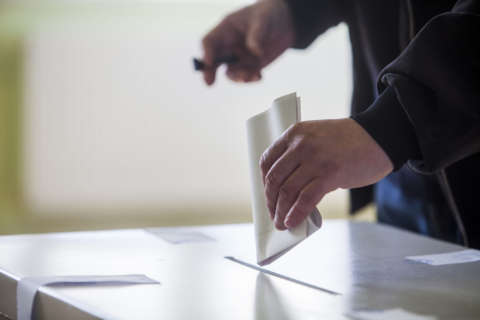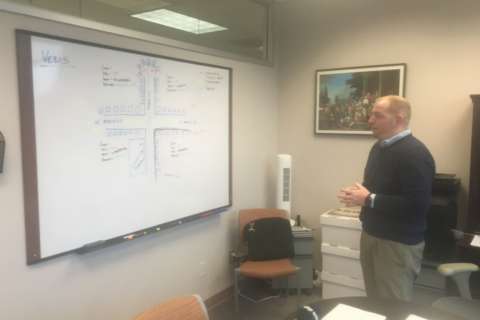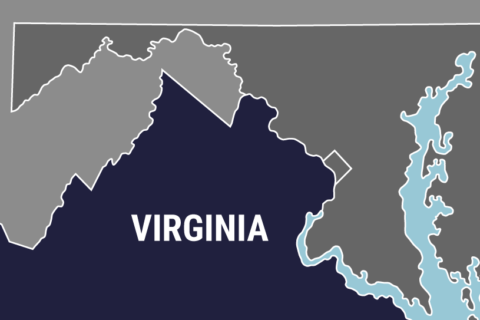WASHINGTON — Several officials at the Virginia Department of Elections and in the City of Fredericksburg were confused about how Virginia’s district lines were defined in the years leading up to the 2017 election, according to documents obtained by WTOP through the Freedom of Information Act.
That confusion likely contributed to 147 people voting in the wrong House of Delegates races Nov. 7.
One of those races, along with control of the House, was decided by just 73 votes.
The process is complicated, and the lines are not defined on a map but are based on the voting precincts that were in place during the most recent census. Those precinct lines immediately become out of date after any General Assembly redistricting process, since local governments are similarly required to redraw lines based on the new population information.
A February 2012 memo from the Division of Legislative Services acknowledged that can be hard to wrap your head around, calling the process “easily misunderstood.”
That memo also warned of the challenges if Virginia tried to keep the law or official maps more up to date.
“Failure to update annually, or mistakes in making updates, could give rise to serious confusion or challenges with regard to candidacies for office, voter participation, election returns and similar issues,” the memo said.
But that is exactly what happened in November, when Republican Bob Thomas beat Democrat Joshua Cole by 73 votes in the 28th District to replace retiring House Speaker Bill Howell.
Fredericksburg area voters, backed by Democrats, still have a [https://wtop.com/virginia/2018/01/gops-thomas-seated-despite-wrong-votes/]pending lawsuit[/] seeking an election do-over due to the issues.
Republicans now hold a 51-49 advantage in the House.
The emails
In 2015 and 2016, some voters’ district assignments were flipped from one district to another after then-Fredericksburg Registrar Juanita Pitchford asked the state Department of Elections for help.
In late April 2015, the Fredericksburg Electoral Board and Pitchford sent a letter to voters explaining that “updates for the House of Delegates Districts 28/88 boundary lines have been completed.”
“Enclosed is a current voter card with your corrected House of Delegates District,” the letter said.
Those corrections came in response to concerns from Howell’s office about a number of misassigned voters they identified in Fredericksburg in the run-up to a primary challenge to Howell from Stafford Supervisor Susan Stimpson.
While Howell’s office was correct, officials at the state Department of Elections did not appear to fully grasp the situation, or understand the details of the way district lines are defined in state law.
“I have a concern. I don’t know if the changes the Speaker [expects are] according to the code,” business analyst Kim Minor wrote to a Department of Elections colleague.
Stimpson expressed similar concerns about the lines at the time, based on the descriptions in state law.
Eventually, many of the proper changes were made for the specific voters identified in emails from Howell’s office to the Department of Elections. Follow-up emails pushed for additional specific fixes that were required even after the department believed the root issues had been resolved.
Not all of the changes made in early 2015 remained permanent though – some of the voters briefly changed to their correct district were later flipped back. Those voters got incorrect ballots in the 2017 race.
In the November election, at least 384 voters were assigned to the wrong districts in Stafford County and Fredericksburg, 147 of whom cast ballots.
The original number of misassigned voters in the 2011 and 2013 elections appears to have been higher, because some areas with incorrect voter assignments that were identified around early 2015 did not appear in final reports on the misassigned voters in 2017.
‘Everything is A-OK!’
In 2016, the Fredericksburg Electoral Board was concerned that precincts were split between two districts, even though state law appeared to suggest the precincts were in only one district. Brooks Braun, at the Department of Elections, emailed Pitchford that “everything is A-OK!” — an example of the confusion warned about in the 2012 legislative services memo.
A bill that would have ended those particular split precincts for the 2017 and 2019 elections passed the General Assembly, but was vetoed by then-Gov. Terry McAuliffe over concerns about gerrymandering. The bill would not have directly solved the problem of voters assigned to the wrong districts, but possibly could have sparked additional reviews.
Even many well-informed voters might not have realized they were getting incorrect ballots, since the state website would have shown the incorrect assignment.
Two of the voters in the ongoing federal lawsuit over the 28th District results only realized the problem at the polls because they had been working on Democrat Joshua Cole’s campaign and knew their home was within the 28th District’s boundaries.
Virginia voter registration system data is entered by local registrars; there is no regular state-level check for accuracy.
There was also no larger investigation to check for other misassigned voters beyond those identified by Howell’s campaign until after the 2017 election.
Since November, registrars in other jurisdictions across Virginia have been attempting to check their own voter databases for any possible errors, often with the help of mapping departments in their own counties or cities








